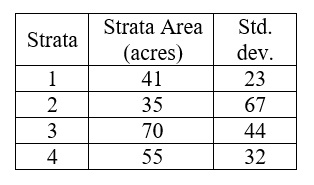NR 421 – Assignment #5
Double Sampling and Ratio Estimation
Objective: This assignment will ask you to explain the process and benefits of double sampling data collection in natural resource management. In doing this you will demonstrate a mastery of sample allocation and stratified data summarization and then begin exploring the calculations of ratio estimation.
Student Learning Outcomes: Upon completing this assignment you should be able to:
- Describe the benefits and limitations of double sampling.
- Explain when it is appropriate to use ratio estimation with double sampling.
- Master the use of sample allocation and stratified data summarization.
- Apply double sampling to estimate a population parameter using ratio estimation.
1. What is the purpose and benefit of double sampling?
2. In double sampling what is the difference between ns and np?
3. What parameters must we know and what do we look for in the relationship between the x and y variables in determining if ratio estimation should be used to calculate the y population mean or total?
4. Describe the three pieces of information that semivariogram analysis can give us.
5. From the given stratification information allocate 115 plots using equal, proportional, and Neyman allocation to each of the strata. Assume each stratum will receive the same plot size.

6. Utilizing the 1 m2 quadrat samples of biomass (kg/m2) from the three designated strata, determine the combined mean biomass per hectare (Mg/hectare) and its associated variance. Assume that stratums one, two, and three are 35, 42, and 60 hectares, respectively. Determine and state if you need to account for the finite population correction factor.
7. Calculate the 90% confidence interval of the total biomass in the three strata given in question #6 and write a statement about this confidence.

8. By looking at the dataset determine if either ratio estimation technique is approapriate for updating the given dataset of an intensive (primary) sampling of timber volume in 2006 with a less intense (secondary) sampling in 2016? Describe why?
9. Using the mean of ratios estimator, calculate the updated total volume and its associated variance for the 2016 sampling in question #8 based on its relationship to the 2006 sampling. Assume that the inventory represents a 112 acre area and that the inventory was performed with 1/10th acre plots.
10. Calculate the 95% confidence interval of the 2016 corrected total volume from question #9 and write a statement about your confidence.

